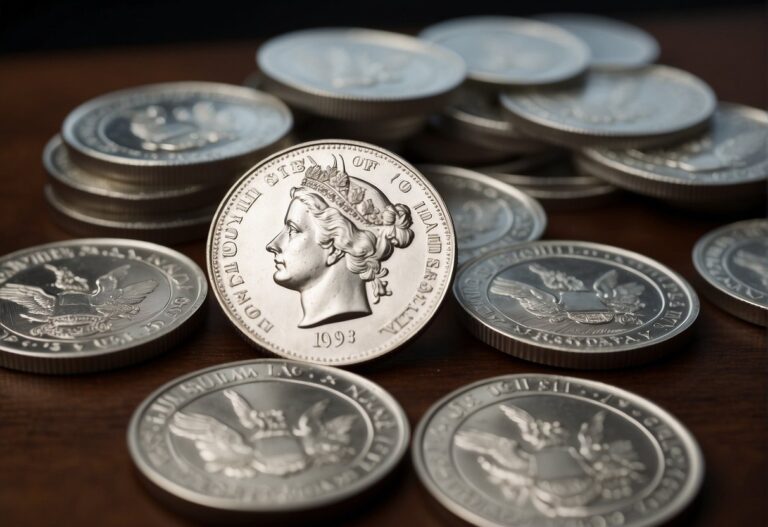The discussion around the BRICS currency price has gained significant momentum among the member nations—Brazil, Russia, India, China, and South Africa. The idea proposes a collective currency that could serve as a medium for trade and investment within the bloc.
The motivation behind this initiative includes reducing dependency on the US dollar and fostering closer financial cooperation among these emerging economies, potentially shaking up global economic dynamics.
Given the reinforced economic position that a unified currency could bestow upon BRICS nations, the proposal has been met with curiosity and skepticism from various quarters.
The valuation of this anticipated currency is a point of intense conjecture, expected to be pegged to a basket of the member countries’ currencies.
Evaluating the impact of such a currency on global trade and its potential to alter the economic influence traditionally wielded by Western economies is essential.
Key Takeaways For A Brics Currency Price
- A unified BRICS currency could diminish member countries’ reliance on the US dollar.
- The new currency’s potential value is speculated to be tied to a basket of BRICS nations’ currencies.
- The creation of a BRICS currency raises questions about its impacts on global trade and economic balance.
Overview of BRICS and the Proposal for a Common Currency
The BRICS are contemplating the creation of a common currency to enhance trade and investment within the group, potentially changing the dynamics of international currency markets.
The BRICS Nations
BRICS encompasses five major emerging economies: Brazil, Russia, India, China, and South Africa. These countries represent a significant share of world economic development and are a force in global affairs.
In terms of currency, each nation operates with its legal tender and faces unique economic challenges and benefits.
Rationale Behind BRICS Common Currency
The objective drives the proposal for a common currency among BRICS nations to bolster internal trade and investment. This move could reduce dependency on major reserve currencies like the U.S. dollar and foster greater economic independence. It could also offer investors new opportunities while increasing the financial stability of member countries, potentially resulting in more coordinated economic policies.
Historical Context for BRICS Currency Price
Historically, currency integration initiatives such as the Euro in Europe have aimed to facilitate trade and provide economic stability. The BRICS’s motivation for a BRICS currency follows a similar logic, intending to support development and economic diversification. This comes in the context of shifting geopolitical alliances and the rising influence of these economies on the world stage.
Economic and Political Implications of a BRICS Currency Price
The potential introduction of a BRICS common currency represents a critical shift challenging established economic dynamics, with far-reaching consequences for international trade and the global balance of power.
Impact on International Trade and Investment
A BRICS currency could significantly alter the landscape of international trade and investment. The new currency would streamline trade processes and reduce dependency on major reserve currencies like the US dollar by facilitating transactions within the bloc. This could increase economic independence among BRICS nations and promote a multipolar global economy.
Response to Western Sanctions and De-Dollarisation
In response to Western sanctions, creating a BRICS common currency is considered a strategic move towards de-dollarisation. This effort reflects a desire to mitigate Western financial systems’ dominance and build internal resilience against external economic pressures, contributing to a more autonomous financial framework for the bloc.
Potential as a Global Reserve Currency
The proposition for a BRICS common currency to act as a global reserve currency poses a significant challenge to the hegemony of the US dollar. Embracing such a currency could trigger diversification in global reserve holdings, potentially altering the current economic order and echoing shifts in the international power structure.
Mechanics of BRICS Currency Price Creation

In creating a BRICS currency, meticulous planning ensures stable integration into global finance. They must establish structures akin to developed economies’ financial systems, including a central bank and currency exchange mechanisms.
Establishing a Common Central Bank
A central bank acts as the foundation for the new BRICS currency. It would orchestrate monetary policy and oversee financial stability across member nations. This institution envisioned providing a collective pool of foreign exchange reserves and a framework for currency exchange rate stabilization.
Brics Currency Exchange Rate Mechanisms
Exchange rate systems would need to be established to determine the new currency’s value relative to existing national and foreign currencies. These mechanisms could operate via a pegged system, a floating system, or a hybrid model, all requiring complex calculations and safeguards to manage currency fluctuations and protect against speculative attacks by currency traders.
National Currencies Vs. New Currency Options
As the BRICS bloc explores new currency options, a decision must be made on whether to fully replace the national currencies or introduce a new currency that circulates alongside them. Harmonizing payment systems and legal frameworks is crucial for adopting new payment options that the new currency would bring into the existing financial ecosystem.
The Role of Macroeconomic Policies and Convergence
The effectiveness of the BRICS currency price pivots significantly on macroeconomic convergence and the alignment of national economic policies. A consistent approach to fiscal and banking policies is essential to ensure stability and foster confidence among member nations.
Macroeconomic Convergence Among Member Nations
Macroeconomic convergence refers to countries aligning their economic policies and performance metrics, resulting in similar inflation, interest rates, and economic growth levels. For the BRICS nations, achieving convergence is crucial for maintaining the price stability of their proposed currency. Member nations strive for alignment in their federal reserve policies and interest rates to facilitate the smooth functioning of a multi-national currency system.
Role of National Economic Policies
Each BRICS country’s national economic policy is pivotal in the currency’s prospects. These policies impact macroeconomic convergence, influencing exchange rates and cross-border investments. Influenced by careful monetary and fiscal policy-making, domestic economic stability underpins the collective financial health necessary for a shared currency.
Fiscal and Banking Union Considerations
A fiscal union involves the integration of member nations’ budgetary policies, while a banking union implies central oversight of financial institutions across the bloc. For BRICS, such unions would require harmonizing banking standards and coordinated fiscal disciplines.
These measures are indispensable for the currency’s stability and to inspire investor confidence in the integrated finance markets of BRICS countries.
International Responses and Strategic Partnerships
In the evolving landscape of global finance, strategic partnerships and international responses shape the potential success of BRICS nations’ endeavors to implement a joint currency. Various alliances and diplomatic engagements are crucial for bolstering the position of their proposed currency in the world economy.
Alliances Beyond the BRICS
While the BRICS nations (Brazil, Russia, India, China, and South Africa) explore reinforcing their economic alliance, they aim to extend their collaborations to include Mercosur and other South American countries.
These partnerships are essential to increase resilience and reduce vulnerabilities in the face of global economic pressures. For instance, Argentina and Brazil have expressed interest in discussing a typical South American currency, which could dovetail with the BRICS’ de-dollarization efforts.
Engagement with Mercosur and Other Nations
The BRICS summit in Johannesburg highlighted the significance of engaging with nations like Saudi Arabia, the United Arab Emirates, and Iran, known for their substantial influence on global energy markets.
The BRICS’ push to trade in their currencies is further supported through dialogues with Egypt and Ethiopia, aiming to consolidate regional ties and create a more diverse economic landscape representing a broader spectrum of the Global South.
The Role of Summit Diplomacy
Summit diplomacy is a pivotal platform for BRICS countries to articulate their shared vision on global financial issues. India’s Foreign Minister participated in a recent summit, emphasizing the group’s commitment to establish a BRICS currency as a means to an end: greater economic independence.
This sentiment is echoed by other foreign ministers within the BRICS, who view these summits as critical opportunities to secure partnerships and gain external support for their monetary aspirations.
Technological Advancements and Financial Innovation

With the BRICS nations pushing the frontiers of economic integration, a significant focus is on incorporating cutting-edge technology and financial innovations to redefine their monetary landscape.
Utilizing blockchain technology and the development of digital currencies, BRICS countries aim to enhance bilateral trade efficiency and secure financial transactions.
The Integration of Blockchain and Smart Contracts
The BRICS nations recognize the transformative potential of blockchain technology in revolutionizing financial transactions. By integrating blockchain, they create a secure, transparent, and efficient transaction processing structure, which could increase economic cohesiveness among the member countries.
Smart contracts stand at the forefront of this innovation, offering unprecedented automation and enforcement in trade agreements and financial contracts without intermediaries.
Emergence of Digital Currencies among BRICS
The evolution of digital currencies within the BRICS consortium signifies a pivotal step towards de-dollarization and establishing a unified currency system for these emerging economies. These countries are exploring the creation of their digital currency to facilitate intra-BRICS trade, potentially increasing the speed of transactions and reducing reliance on traditional foreign exchange mechanisms. This trend is a clear response to the global financial shifts and the need for a more resilient economic framework within the BRICS group.
Trade and the BRICS Currency Price
The introduction of a BRICS currency has the potential to significantly impact commodity trade within the bloc, offering alternative avenues for oil trading and addressing trade imbalances influenced by dollar exchange rate fluctuations.
Influence on Commodity Exports and Imports
The BRICS nations—Brazil, Russia, India, China, and South Africa—possess diverse and rich commodity reserves. A unified BRICS currency could streamline transactions for commodity exporters and importers by reducing dependency on the US dollar and minimizing exchange rate volatility. This simplicity could attract investment, making the BRICS nations more competitive in global commodity markets.
Oil Trading and Brics Currency Price Fluctuations
Oil trade stands to be markedly influenced by the adoption of a BRICS currency. As oil transactions are primarily conducted in US dollars, introducing a BRICS currency might allow member countries to stabilize their oil trade against global dollar exchange rate fluctuations. This financial control could benefit oil exporters like Russia and importers like India and China by reducing transaction costs and exchange rate risks.
Managing Trade Imbalances within the BRICS Bloc
BRICS nations experience varying degrees of trade imbalances, often exaggerated by the fluctuations in the dollar’s exchange rate. A common BRICS currency could provide a mechanism to balance trade within the bloc more efficiently.
By utilizing a collective currency, members may achieve better terms of trade and have enhanced capabilities to manage trade deficits and surpluses amongst themselves.
Challenges and Critics of the BRICS Currency Price Initiative
Establishing a common currency among the BRICS nations faces significant challenges. Critics argue it could render these countries vulnerable to global volatility, especially considering their varying economic landscapes. Unilateral measures and sanctions from more dominant economies may also impact the initiative, influencing trade dynamics and investment flows.
Economic Heterogeneity and Trade Imbalances
- BRICS countries have distinctive economic profiles
- Wide disparities in trade balances exist
- Risk: Amplified strain on individual nations, potentially exacerbating trade imbalances
Monetary Policy and Fiscal Sovereignty
- Potential loss of policy autonomy for individual nations
- Challenges in synchronizing fiscal and monetary policies across diverse economies
External Pressures and Sanctions
- Exposure to sanctions could undermine the currency’s stability
- Borrowers and lenders within the BRICS may face uncertain regulatory environments
The renminbi’s role has been spotlighted as potentially central to the initiative, yet critics question the currency’s ability to shield BRICS from unilateral measures. Furthermore, while the initiative could offer advantages such as reducing dependency on established currencies, The Economist underlines the need for sturdy financial systems to manage the implications effectively.
In summary, while the potential benefits are evident, the BRICS currency initiative requires navigating various economic and political factors to achieve fruition.
Brics Currency Price FAQs
In this section, we address common inquiries regarding the BRICS currency concerning its valuation, market predictions, acquisition platforms, historical price trends, its status on cryptocurrency, and information on airdrops.
How do you determine the current value of the BRICS currency Price in USD?
To find the current value of the BRICS currency in USD, one must look at the exchange rates of the individual currencies of the BRICS nations against the United States Dollar. Global currency markets determine these rates and can be found through financial news outlets and currency converters.
What are the latest predictions for the BRICS currency price fluctuations?
Analysts offer predictions for BRICS currency price fluctuations based on economic indicators, geopolitical stability, trade balances, and policy decisions within the member countries. The diverse economies of the BRICS nations can lead to varying forecasts.
What platforms offer the purchase of BRICS currency?
Investors can purchase BRICS currencies through foreign exchange markets, international brokers, or platforms specializing in global currency trade. These platforms provide opportunities to buy, sell, and exchange the currencies of Brazil, Russia, India, China, and South Africa.
How has the BRICS currency price varied over time according to historical charts?
Historical charts show that the BRICS currency price has experienced variations over time, reflecting changes in economic conditions, trade relationships, and other factors impacting each nation’s currency. These trends are documented in financial publications and market analysis tools.
Is BRICS considered a form of cryptocurrency?
BRICS currency is not a form of cryptocurrency. It comprises the sovereign fiat currencies of the five member nations, which are government-issued and regulated, as opposed to decentralized digital currencies like Bitcoin or Ethereum.
What are the steps for participating in a BRICS Coin airdrop?
There have been discussions of a common BRICS digital currency, but there are no official steps to participate in a BRICS Coin airdrop. Any future airdrop would likely involve specific eligibility criteria and instructions provided by the overseeing financial institution.



